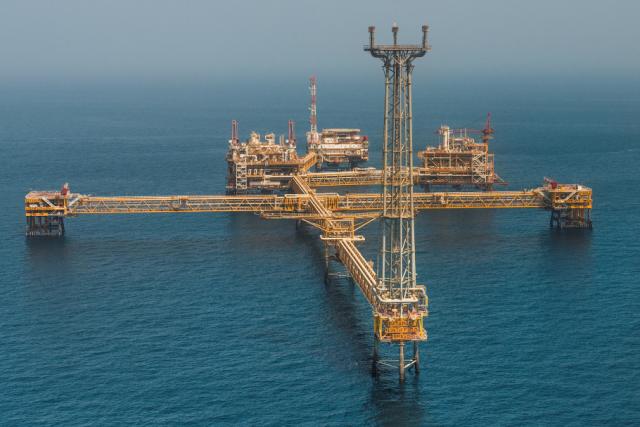
The project would increase the North Field’s production by 10%, adding about 400,000 barrels of oil equivalent per day. (Source: Qatargas)
Qatar Petroleum recently announced it awarded a detailed design contract to U.S. engineering firm McDermott International Inc. (NYSE: MDR) for offshore jackets for the new North Field expansion project. The company said the design of the jackets is an important step toward awarding the procurement, fabrication and installation contract by year-end 2018, which will pave the way to start the 2019 drilling campaign.
The move is part of Qatar Petroleum’s drive to monetize its gas reserves. The company announced in 2017 the self-imposed moratorium on developing the North Field, the world’s biggest natural gas field, was lifted after more than a decade. Qatar declared a moratorium in 2005 on development of the North Field, at the time saying it needed time to study the impact on the reservoir from a rapid increase in output.
Qatar Petroleum plans to develop a new gas project in the southern sector of the North Field. The company has entrusted Qatargas to execute this megaproject. In January, Qatar merged its two LNG producers—Qatargas and RasGas—under a single operator, Qatargas. Its shareholders include Qatar Petroleum, Exxon Mobil Corp., Total, ConocoPhillips, Shell, Mitsui and Marubeni.
In March Qatar selected Japan’s Chiyoda Corp. to carry out FEED work for three new 7.8 million tons per annum (mtpa) onshore LNG production trains.
“This is yet another milestone on the road to implementing one of the most ambitious gas projects in the southern sector of the North Field and starting the first LNG production from the new LNG mega train by the end of 2023,” Qatar Petroleum CEO Saad Sherida Al-Kaabi said, adding it will increase LNG production capacity from 77 mtpa to 100 mtpa.
The project would increase the North Field’s production by 10%, adding about 400,000 barrels of oil equivalent per day. “With a targeted capacity of 4.6 billion cubic feet per day, the North Field expansion project will add about 1 million barrels per day of oil equivalent to the state of Qatar’s production,” Al-Kaabi said.
The awarded scope is part of a larger wide-ranging offshore scope, which consists of six wellhead platforms, jackets and associated intra-field and main trunk lines to shore. The offshore facilities will be integrated with the three new LNG trains.
The Gulf gas field, which Qatar calls the North Field and Iran calls South Pars, accounts for nearly all of Qatar’s gas production and about 60% of its export revenue. Iran and Qatar hold the world’s second- and third-largest natural gas reserves, respectively, behind Russia. Their South Pars/North Field gas field holds an estimated 50.97 trillion cubic meters of in-situ gas and some 50 billion barrels of condensates, according to the International Energy Agency.
Qatar joined major international firms to develop the field, becoming the world's largest exporter of LNG. Meanwhile, Iran’s development of South Pars has been hampered by protracted delays, mainly because of international sanctions.
While competition between LNG producers is set to intensify over the next few years as projects come onstream such as in Australia, Qatar is set to cement its position as a leading LNG producer. Qatari LNG is viewed as highly competitive, given its track record in gas production and LNG production and exports.
“With global activity levels and costs low, now is a good time to add new capacity even if the LNG market does presently look over supplied,” said Giles Farrer, research director of global gas and LNG supply for at Wood Mackenzie. “By the time new capacity is commissioned in 5-7 years’ time, new pre-FID LNG supply is likely to be required in the global market.
“It’s a signal that Qatar intends to increase its market share, which has been falling as other regions have built new capacity,” Farrer added. “But it is also a threat to other developers of new capacity worldwide, as Qatar can add new capacity at a lower cost than anybody else.”
Recommended Reading
Williams Cos. COO Dunn to Retire
2025-03-13 - Williams Cos. COO Micheal Dunn was crediting with helping the company focus on a natural gas strategy.
Chevron Technology Ventures Would Like to See the Manager
2025-03-13 - Chevron Corp.’s Chevron Technology Ventures, which turns 25 this year, pays close attention to leadership teams when making investment decisions in technology startups.
Enbridge Appoints Steven Williams to Chair of the Board
2025-03-12 - Enbridge has appointed Steven Williams to lead the board of directors following Pamela Carter’s retirement as chair.
BlackRock CEO: US Headed for More Inflation in Short Term
2025-03-11 - AI is likely to cause a period of deflation, Larry Fink, founder and CEO of the investment giant BlackRock, said at CERAWeek.
Baker Hughes to Supply Equipment for NextDecade’s Rio Grande LNG
2025-03-11 - Baker Hughes will provide turbine and compression for NextDecade’s trains at Rio Grande LNG.
Comments
Add new comment
This conversation is moderated according to Hart Energy community rules. Please read the rules before joining the discussion. If you’re experiencing any technical problems, please contact our customer care team.






